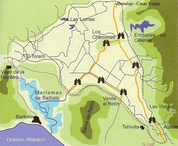
(Guia de Aves del Estrecho de Gibraltar)
ISBN – 84-607-4545-7 David Barros Cardona & David Rios Esteban Ornitour (2nd edition 2008) 115 plates c350 species
In some ways this is a very curious book. In geographical scope it's an oddity covering the southern half of Cadiz province and a small area in North Africa (largely the Spanish enclave of Cueta). It's a bilingual book that aspires to be part field guide, site guide, atlas and local avifauna which has no parallel amongst British bird books. The problem with covering so many bases is that there's a danger of falling between stools. So how well does it do and is it worth getting?
The bilingual element – Spanish/English – is a two edged sword. On the one hand it gives the notoriously monoglot Brit (like me) a chance to tap into local Spanish expertise and knowledge. However, it means that everything has to be repeated in each language and consequently there's less information than might otherwise be the case in a book this size (i.e. 328pp in field guide format). Consequently, guidance on identification and much else tends to be very brief. The sixty page introduction, rather like a county avifauna, gives an overview of the area's ornithological history, climate, habitats, bird distribution and, particularly, bird movements (illustrated by drawings, maps and over 30 photos). Although informative, the text is again necessarily brief.


 Map of La Janda from the guide
Map of La Janda from the guide Finally, there's a dozen pages on where to look for birds. Seven sites – Breňa & Barbate, Marismas del Río Palmones, Río Guadiaro (Sotogrande), Playa de los Lances and Upper rock (Gibraltar), La Janda and Sierra de Crestellina [Casares] – are briefly described and each has a map. They're certainly better that nothing, but they give a pretty basic grasp of where to go so need to be supplemented by a good site guide such as Garcia & Paterson. the location of all the principal raptor watchpoints are also shown on a map of the area

 RSS Feed
RSS Feed
